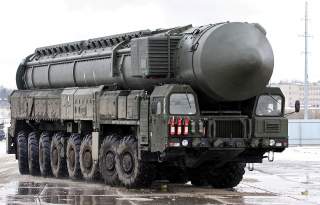Could America Really Destroy an ICBM in a War?
Yes, the latest missile defense test was a success. But what happens in wartime conditions when all is not perfect?
The Pentagon’s Missile Defense Agency (MDA) demonstrated the ability to intercept an intercontinental ballistic missile (ICBM) using Ground-based Midcourse Defense (GMD) interceptors for the first time during a live test on May 30.
According to the MDA, the test looks likely to have been a success—though the agency will have to analyze the data to be sure. During the test, a roughly five-foot long Raytheon-built exo-atmospheric kill vehicle slammed head-on directly into an ICBM-class test target that was launched from the Reagan Test Site on Kwajalein Atoll in the Republic of the Marshall Islands (in the Pacific). The U.S. Air Force’s 30th Space launched the interceptor missile Wing from Vandenberg Air Force Base in California.
"The intercept of a complex, threat-representative ICBM target is an incredible accomplishment for the GMD system and a critical milestone for this program," MDA Director Vice Adm. Jim Syring said in a statement. "This system is vitally important to the defense of our homeland, and this test demonstrates that we have a capable, credible deterrent against a very real threat. I am incredibly proud of the warfighters who executed this test and who operate this system every day."
The MDA notes that intercepting the Orbital-built ICBM target required precise coordination from multiple sensors across the globe. Northrop Grumman’s sophisticated Command, Control, Battle Management and Communication (C2BMC) system integrated data from Raytheon’s forward deployed AN/TPY-2 and the Sea-Based X-band radar—positioned in the Pacific Ocean— to develop target tracking data and a fire control solution to intercept the target.
Boeing, which is the prime contractor for the overall GMD system, was thrilled with the results of the test—which pave the way for expanding the expansion of the entire construct.
“This successful test keeps the United States on track for a significant increase in interceptor inventory of 44 in 2017,” Norm Tew, Boeing’s vice president and GMD program director said. “In addition, the GMD program remains on track to evolve and modernize this crucial national defense asset in the face of an evolving threat environment, with system upgrades and future technology including the Boeing-led Redesigned Kill Vehicle (RKV).”
The MDA cautions that data from the test still has to be analyzed to be sure that the intercept worked properly.
“Initial indications are that the test met its primary objective, but program officials will continue to evaluate system performance based upon telemetry and other data obtained during the test,” the MDA states. Altogether, the test cost roughly $244 million.
Though the test has been portrayed as a signal to North Korea, in reality it was a happy coincidence—the intercept test has long been in the works. The MDA argues that the GMD was tested in an operationally setting against a target—complete with decoys—representative of a threat well into the 2020s.
“This did represent a very real operational scenario in the Pacific,” Syring told reporters at the Pentagon on May 31.
However, critics contend that the GMD system—as it currently stands—has not demonstrated the ability to intercept a real ICBM under wartime conditions. In fact, such a capability is a long way off. Indeed, according to the GAO, the MDA won’t even test the system in the rain.
“Not even close,” Jeffrey Lewis, Director of the East Asia Nonproliferation Program at the James Martin Center for Nonproliferation Studies at the Middlebury Institute of International Studies at Monterey told The National Interest. “It's a nice baby step.”
Even if the MDA conducted tests under realistic conditions, the program is still essentially a research and development program in many ways. The agency—which is not part of any military service—does not have a strategy or doctrine on how to use the system operationally.
“The MDA is still running a technology development program and hasn't really thought about transitioning it to an credible operational capability, despite their silly pronouncements to the contrary,” Lewis said.
Moreover, in Lewis’ view, nor does the MDA have the capacity to transition the GMD into a genuine operational capability to defend the United States.
“I don't think MDA has the capacity, no. I would return the mission to the services,” Lewis said. “Basically, we should treat missile defense like any other defense program. If it provides a cost-effective military benefit, great. If not, spend the money on something that does.”
At the end of the day, even if all of the GMD’s technical issues were solved, the system has one major Achilles’ Heel—it can be overwhelmed. That’s one the reasons that Russia and China’s nuclear deterrents are—in practical terms—not impacted by U.S missile defenses; the United States just does not have enough interceptors to stop such huge arsenals.
“The current doctrine is to salvo fire multiple (like 5) interceptors at each target,” Lewis said. “The scaling is not friendly. Also, the interceptors don't self-destruct so they fly right into Russia.”
Ultimately, nuclear weapons are still a potent deterrent for adversaries of the United States. Unless a missile defense shield is 100 percent effective—which no such system can ever hope to be—no sane U.S. President would be willing to risk the safety of a major American metropolitan area to a nuclear attack in order to push a political agenda such as regime change. Thus, while a missile shield is nice to have for emergencies such as surprise North Korean attack, it is dubious that Pyongyang will ever give up its nuclear ambitions.
Dave Majumdar is the defense editor for The National Interest. You can follow him on Twitter: @Davemajumdar.
Image Credit: Creative Commons.

